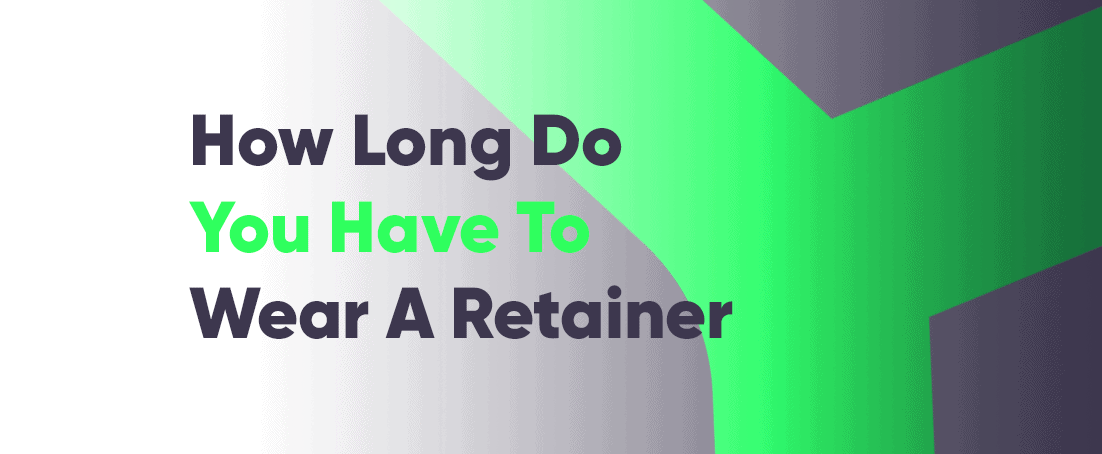Retainers serve a straightforward purpose: preserving the outcomes of orthodontic treatments by keeping teeth straightened. Orthodontists advise wearing retainers for at least 10 years post-braces or aligner treatment, with many individuals wearing them lifelong, ideally a few nights weekly. However, the duration of wearing a retainer varies depending on factors like individual orthodontic needs, treatment outcomes, and orthodontist guidance. How long do you have to wear a retainer is a question with no one-size-fits-all answer.
By delving into the factors, you can gauge how long you need to wear transparent retainers. Continue reading to learn about the expected duration if you’re at the stage of wearing them.
Table of Contents:
Purpose of Wearing Retainers
Even after months or years of orthodontic treatment with braces or aligners, teeth may shift back to their original positions, a phenomenon called teeth shifting. Clear retainers such as those from Invisalign, Byte, or Candid are custom-molded to fit teeth precisely, acting as a barrier against unwanted tooth movement. How long you wear them is important to determine retention success.
The primary purpose of wearing retainers is to preserve the alignment achieved through orthodontic procedures. Retainers are designed to provide consistent gentle pressure which prevents teeth from shifting back to their original positions. A recent meta-analysis revealed that removable retainers are particularly effective in this regard, demonstrating their ability to maintain dental alignment after orthodontic treatment.
This highlights the importance of consistent retainer wear as prescribed by orthodontists to safeguard the investment made in achieving a straighter smile and to prevent any regression in alignment over time.
Initial Phase of Retainer Wear
Wearing retainers consistently right after orthodontic treatment with braces or aligners is crucial to stabilize teeth in their new positions. Without them, teeth are prone to shifting back. Initially, orthodontists typically advise that retainers need to be worn full-time for a few months, removing them only for eating, brushing, or special occasions.
This phase transitions to part-time wear, often at night, after several months. The retention period varies case by case, lasting from months to years. You should follow the orthodontist’s instructions precisely, as different types of retainers require different treatment approaches.
Transition to Nighttime Retainer Wear
As stability is achieved, full-time retainer wear typically transitions to nighttime wear. The orthodontist, after a detailed dental exam, determines the right time for this shift for you. After several months to a year of full-time wear, depending on the case, your orthodontist usually recommends that the retainers should be worn only at nighttime.
This transition is vital for preserving the ideal teeth alignment you achieved with braces or Invisalign. You have to follow the orthodontist’s guidance on retainer wear and maintenance which is crucial for maintaining orthodontic results.
Factors That Influence How Long You Need To Wear Retainers
1 Your Individual Orthodontic Needs
Individual orthodontic needs determine how long you need to wear a retainer. While some may only need to wear a retainer for a short period to maintain their teeth alignment, others may require more prolonged wear for optimal results. When you consult your orthodontist, he conducts a thorough teeth exam to assess your individual needs to decide how long you need to use a retainer.
Approximate duration of wearing retainers for different orthodontic conditions:
- Open Bite: 1-2 years full-time wear, followed by several years of nighttime wear, potentially lifelong.
- Crossbite: Depending on severity. 1-2 years full-time, followed by long-term nighttime or specific day wear.
- Overbite: 6-12 months full-time, followed by 1-3 years of nighttime wear, potentially transitioning to fewer nights depending on the severity.
- Overjet: Ranging from 6-12 months full-time, followed by 1-3 years of nighttime wear, with potential adjustments based on severity.
- Underbite: Ranging from 6-12 months full-time, followed by 1-3 years of nighttime wear, with potential adjustments based on severity.
- Teeth Crowding: 6-12 months full-time, followed by 1-2 years of nighttime wear, potentially reduced to specific days later.
- Gap Teeth: 6-12 months full-time, followed by 1-2 years of nighttime wear, potentially reduced to specific days later.
- Missing Teeth (with replacement): Varies depending on the replacement method (bridge, implant). Typically, 6-12 months full-time, followed by long-term nighttime wear to maintain alignment with the replacement.
- Jaw Misalignment: Depending on the type and severity of the misalignment. In general, expect at least 1-2 years of full-time wear, followed by several years of nighttime wear or specific day wear, potentially lifelong.
Factors such as the severity of the initial misalignment, the complexity of the orthodontic treatment, and individual variations in tooth stability all play a role in determining the appropriate duration of retainer wear for each patient.
2 Type of Your Orthodontic Treatment
The type of orthodontic treatment you got plays a crucial role in determining your retainer treatment plan.
For patients who have used braces and battled crowded teeth or misaligned bites with brackets and wires, the commitment with retainers tends to be longer. Their teeth, having undergone significant shifts with the use of braces, require more vigilant stabilization. Typically, full-time wear for the first 6 months to a year is recommended, followed by a recommendation to wear nightly for at least a year or several years, sometimes even indefinitely.
Approximate duration of retainer wear for different orthodontic treatment type:
- Braces: After wearing braces for an average of 18-24 months, most orthodontists recommend wearing a retainer full-time for the first 3-6 months, followed by nightly wear for several years, sometimes even indefinitely.
- Clear aligners: After wearing aligners for an average of 6-12 months, most orthodontists recommend wearing a retainer nightly for at least 6 months, and then possibly switching to just a few nights per week thereafter.
- Headgear: After using headgear, you will likely need to wear a retainer for at least as long as you wore the headgear, and possibly longer.
- Expanders: After using an expander, you will typically need to wear a retainer for at least 6 months to a year.
- Retainers after wisdom teeth removal: If you have had your wisdom teeth removed, your orthodontist may recommend wearing a retainer for a short period of time to prevent your other teeth from shifting into the empty spaces. Incorporating gentle jaw exercises after wisdom teeth removal can also help reduce any tension, ensuring a smoother transition to wearing your retainer at night.
Patients who received Invisalign or other clear aligner treatment might enjoy a bit more freedom. Since aligners typically address milder cases, the retainer phase can be shorter. Often, 6-12 months of nightly wear is sufficient, though some cases with the history of prolonged Invisalign use might require longer stretches.
Customized advice from the orthodontist is vital in deciding the duration of retainer wear for every individual, whether they have had Invisalign clear aligners, braces or retainers of other types in the past, such as a permanent retainer.
3 Age and Skeletal Maturity
Age and skeletal maturity are key factors in determining retainer wear duration. Children and teenagers may need to wear retainers for several years to maintain orthodontic results, while adults may require lifelong wear. The orthodontist considers occlusal and craniofacial changes, treatment plans, oral hygiene, and habits.
Age:
- Younger patients: As bones and jaws are still growing and developing in younger individuals, they are generally more susceptible to movement and relapse after orthodontic treatment. This means younger patients typically require longer periods of retainer wear, often full-time initially followed by extended nighttime or specific day wear for several years, sometimes even indefinitely.
- Older patients: In adults, bones and jaws are more stable, making them less likely to shift after treatment. While retainers are still crucial to prevent minor changes, older patients might benefit from slightly shorter wear durations, potentially transitioning to fewer nights per week after an initial adjustment period.
Skeletal maturity:
This refers to the completion of bone growth and development, particularly in the jaw area. Assessing skeletal maturity helps dentists and orthodontists predict future jaw growth and its impact on teeth alignment.
- Less mature patients: When bones haven’t reached full maturity, there’s a higher chance of continued jaw growth affecting tooth position. These patients require longer retainer wear durations to ensure stability throughout the growth process.
- More mature patients: With complete bone development, the risk of significant jaw growth-related relapse is lower. These patients might have shorter retainer wear periods, but consistency is still important to maintain the achieved results.
Personalized recommendations guide the transition from full-time to nighttime wear, ensuring stability.
Long-Term Retainer Wear Considerations
You can expect to wear a retainer for a minimum of 10 years, possibly indefinitely. For some individuals, wearing a retainer may become a lifelong practice to ensure optimal dental alignment over time.
Even after this stabilizing process, teeth can still shift gradually. Long-term retainer wear helps prevent this by holding teeth in place. If you are in a similar situation and wonder can an old retainer straighten teeth? It is important to remember that retainers are not designed to apply the steady force needed for teeth movement.
Therefore, following an orthodontist’s instructions for retainer wear is essential for maintaining a straight and beautiful smile throughout life. Remember, choosing high-quality retainers like Remi guarantees that your commitment to adhering to retainer wear duration is not in vain.
Common Questions
Is there a specific age when retainer wear can be discontinued?
Discontinuing retainer wear doesn’t hinge on a specific age but rather on individual orthodontic requirements. The duration of retainer wear may vary depending on factors such as treatment outcomes and the stability of your teeth. Ultimately, your orthodontist will advise you on when it’s appropriate to stop wearing your retainer.
Can I stop wearing my retainer if my teeth feel stable?
While stable-feeling teeth may seem like a cue to cease wearing a retainer, it’s prudent to consult your orthodontist first. They can assess your dental stability and provide guidance on whether it’s safe to discontinue retainer wear to maintain your smile’s alignment over the long term.
How often should I visit my orthodontist to check my retainer?
Regular visits to your orthodontist are crucial for ensuring the effectiveness of your retainer. Typically, check-ups every 6-12 months allow your orthodontist to monitor your dental progress and make any necessary adjustments to your retainer plan.
Will my retainer wear routine change over time?
Over time, your retainer wear routine may evolve to suit your changing dental needs. Your orthodontist may recommend adjustments to the frequency or duration of retainer wear based on your progress and long-term oral health goals.
Can adults stop wearing retainers sooner than teenagers?
The duration of retainer wear isn’t dictated solely by age; rather, it’s determined by individual orthodontic needs, and whether you achieved straight teeth with braces or Invisalign. While teenagers and adults may have different treatment timelines, both groups may require long-term retainer wear to effectively maintain the results of orthodontic treatment.
What happens if I don’t wear my retainer as directed?
Non-compliance can be risky! You have to wear your retainer as directed to avoid unwanted shifting of your teeth back to their original positions. This can compromise the results achieved through orthodontic treatment, potentially necessitating additional corrective measures in the future. Consistent retainer wear is essential for preserving the alignment of your teeth and avoiding longer future wear or even orthodontic re-treatment.
Key Takeaways
In conclusion, we can say that the duration of wearing a retainer varies for each individual, influenced by factors like orthodontic needs, treatment type, age, and skeletal maturity. Some may need retainers for a few years, while others may require lifelong wear. You need to get a personalized recommendation from orthodontists which is crucial for achieving lasting results.
It’s essential to follow their guidance diligently and maintain open communication throughout the retainer-wearing journey. By doing so, individuals can preserve their beautiful smiles and enjoy optimal dental alignment for years to come.

